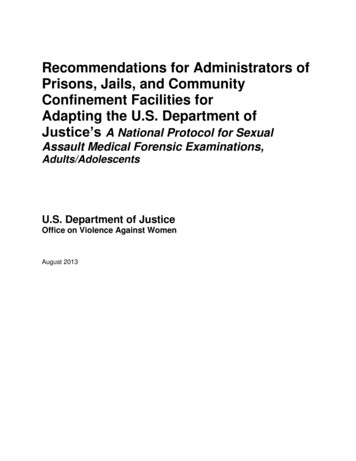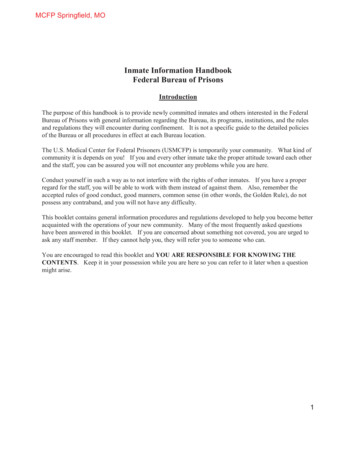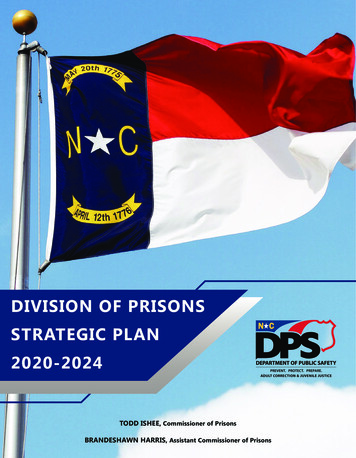
Transcription
Recommendations for Administrators ofPrisons, Jails, and CommunityConfinement Facilities forAdapting the U.S. Department ofJustice’s A National Protocol for SexualAssault Medical Forensic Examinations,Adults/AdolescentsU.S. Department of JusticeOffice on Violence Against WomenAugust 2013
TABLE OF CONTENTSAcknowledgements. 3Recommendations at a Glance for Administrators of Prisons, Jails, andCommunity Confinement Facilities . 5Introduction to the Guide . 121. Purpose and Scope . 122. Limitations in Scope . 133. Background . 144. Organization . 155. Explanation of Terms . 16I. A Primer on Corrections-Based Sexual Assault. 211. Dynamics . 212. Prevalence and Incidence . 223. Reporting: Too Many Risks, Not Enough Benefits? . 234. Who is Most At Risk? . 265. Potential Repercussions. 26II. Overview of the Sexual Assault Medical Forensic Examination for Victims inCorrectional Facilities . 301. Elements of an Immediate Response to Sexual Assault . 302. Core Responders . 303. Activating a Coordinated Response and Conducting an Examination . 314. A Protocol for Immediate Response and the Examination Process . 325. Usefulness of a Correctional Protocol . 336. Collaboration in Protocol Development and Implementation. 33III. Recommendations . 351. Recommendations for Victim-Centered Care. 352. Recommendations for Promoting a Coordinated Team Approach . 46Appendix A. Bibliography . 51Appendix B. Issues and Recommendations for Lockups . 54Appendix C. Issues and Recommendations for Juvenile Detention Facilities . 56Appendix D. Possible Roles of Core Responders . 58Appendix E. An Assessment Tool for Corrections AdministratorsDrafting/Revising Protocols for an Immediate Response to Sexual Assault . 642
AcknowledgementsThe Office on Violence Against Women is grateful to all of the individuals involved in this project for theirdedication to ensuring that those who suffer sexual assault while incarcerated are afforded the same careand attention as those who are assaulted in the community. Special thanks to the Federal Bureau ofPrisons, Vera Institute of Justice, Kristin Littel, and the work group participants for their time, energy, andcontributions.Work Group ParticipantsWaseem AhmedDallas County Jail, TexasDon BirdPitkin County Jail, ColoradoCharma BlountTexas Department of Criminal JusticeAntonio BookerJohnson County Department of Corrections,KansasLorie BrisbinNational Institute of CorrectionsJane BrowningInternational Community CorrectionsAssociationMargaret ChiaraNational Prison Rape Elimination CommissionRick ClukeyPenobscot County Sheriff’s Office, MaineLiz CurtinCommunity Resources for JusticeKim DayInternational Association of Forensic NursesJim DennisCorrectional Center of Northwest OhioJennifer FeichtPennsylvania Coalition Against RapeCari GerlicherMinnesota Department of CorrectionsDebra HerndonCalifornia Department of Corrections andRehabilitationGary JunkerFederal Correctional Complex Butner, NorthCarolinaLinda McFarlaneJust Detention InternationalSuzy MalagariMontgomery County Correctional Facility,MarylandShannon MayJust Detention InternationalChuck MedleyMacomb County Jail, MichiganMark McCorkleLos Angeles County Sheriff’s Office, CaliforniaDenise RobinsonAlvis House, OhioJames ShannonMontgomery County Department of Correction andRehabilitation, Pre-Release Center, MarylandLynne SharpTexas Department of Criminal JusticeJennifer TrovillionU.S. Department of Justice, Office of JusticeProgramsTherese WagnerMaricopa County Adult Probation, ArizonaJaime YarussiProject on Addressing PrisonRape, The Washington College of LawAdditional Individuals InterviewedBeth BarnhillIowa Coalition Against Sexual AssaultBarbara BroderickMaricopa County Adult Probation Department,ArizonaKristin BrownFederal Bureau of PrisonsAmanda ChoiU.S. Marshals ServiceSarah DraperGeorgia Department of CorrectionsSheri FloydIowa Coalition Against Sexual AssaultCat FribleyIowa Coalition Against Sexual AssaultBetsy GillespieJohnson County Department of Corrections,KansasCharles GruberRetired Police Chief, Policing ConsultantSteven G. JettSouthwest Idaho Juvenile Detention Center3
Juan LopezGlendale Police Department, CaliforniaMarty OrdinansWisconsin Department of CorrectionsEdith PickensU.S. Marshals ServiceSara RevelleFederal Correctional Center Butner, NorthCarolinaDavid W. RoushJuvenile Justice AssociatesDana ShoenbergCenter for Children’s Law and PolicyJeff ShorbaMinnesota Judicial BranchMark SolerCenter for Children’s Law and PolicyJason SzanyiCenter for Children’s Law and PolicyCathy Jo VeroniTalbert House, OhioJerry VroeghFederal Bureau of PrisonsMike WeaverAmerican College of Emergency PhysiciansShane WylieMontgomery County Correctional Facility,MarylandOffice on Violence Against WomenKim GalvanKathrina PetersonMarnie ShielsVera Institute of JusticeTara GrahamAllison HastingsConsultantKristin Littel4
Recommendations at a Glance for Administrators ofPrisons, Jails, and Community Confinement Facilities(See the Introduction to the Guide for more background information and more explanation of terms usedin Recommendations at a Glance.)This guide is designed to assist administrators of prisons, jails, and community confinementfacilities in drafting or revising protocols for an immediate response to reports of sexual assault.Sexual assault is a persistent problem in correctional environments with life-altering consequences for1victims as well as for the integrity of correctional institutions and the fundamental principles of justice.2The U.S. Department of Justice’s National Standards to Prevent, Detect, and Respond to Prison Rapeset minimum requirements for correctional facilities to increase their overall capacity to address theproblem of sexual assault. This guide is intended to help these facilities comply with the Prison RapeElimination Act (PREA) standards, which require correctional agencies to (1) follow a uniform evidence3protocol when responding to sexual assault, which as appropriate is based on the U.S. Department of4Justice’s A National Protocol for Sexual Assault Medical Forensic Examinations: Adults/Adolescents, 2d.(referred to in this guide as the National Protocol), and (2) coordinate responses to sexual assault among5involved professionals. In acknowledgement that professionals outside of the correctional field may alsobe reading this guide, it includes some explanation of basic corrections terms, issues, and activities. Notethat beyond the stipulations of the Department of Justice’s PREA standards, the recommendations in thisguide are not meant to supersede or invalidate previously established institutional protocols, policies, orpractices that address the immediate response to sexual assault in correctional settings.Recommendations at a Glance highlights the key recommendations offered in this guide for customizingthe National Protocol to address sexual assault occurring in correctional facilities (often referred to in thisguide as corrections-based sexual assault). It is not meant to be a stand-alone checklist for drafting orrevising facility protocols on an immediate response to sexual assault. Rather, the full guide should beread to understand the complex issues surrounding this crime and to utilize the comprehensiverecommendations in Section III to assist in policy development. The guide should be used in conjunctionwith the National Protocol, as together they offer best practices for an immediate response to sexualassault in correctional settings. As explained in Section II of the guide, elements of an immediate6response to sexual assault can include: Protection for victims from threats of imminent harm; Provision of medical care for victims (for acute injuries and health concerns related to the assaultsuch as risk of HIV/AIDS, sexually transmitted infections, and pregnancy); Collection of forensic evidence from victims, which may aid investigations; Preliminary documentation and investigation (which may lead to criminal charges against suspects,prosecution, and conviction, as well as administrative findings of sexual assault, a formal disciplinaryprocess, and/or disciplinary sanctions); and Support, crisis counseling, information, and referrals for victims (and their families as applicable), aswell as advocacy to ensure victims receive appropriate assistance.A sexual assault medical forensic examination (referred to in this guide as the medical forensicexamination or examination) addresses victims’ health care needs related to the assault and the7collection of forensic evidence. The process of facilitating this examination for victims housed incorrectional facilities (referred to in this guide as the examination process) can involve all the elements of1National Prison Rape Elimination Commission, Standards for the Prevention, Detection, Response, and Monitoring of SexualAbuse in Adult Prisons and Jails (2009), p.iii.2National Standards to Prevent, Detect, and Respond to Prison Rape, Final Rule, 77 Fed. Reg. 37106-37232 (June 20, 2012) (to becodified at 28 C.F.R. §115).328 C.F.R. §§ 115.21, 115.121, 115.221, and 115.321.4Office on Violence Against Women, A National Protocol for Sexual Assault Medical Forensic Examinations, Adults/Adolescents,2d., Washington, D.C.: U.S. Department of Justice (2013).528 C.F.R. §§ 115.65, 115.165, 115.265, and 115.365.6Bullets adapted from Office on Violence Against Women, A National Protocol (2013), p.12.7Adapted from Office on Violence Against Women, A National Protocol (2013), p.17.5
an immediate response. Hence, the guide discusses an immediate response to corrections-based sexualassault. Note that while it focuses on response to recent sexual assault, the guide recognizes andspeaks to the fact that it is not uncommon for victims to delay reporting for days, weeks, months, and8even years after an assault has occurred.The National Protocol provides guidelines for jurisdictions on responding to the immediate needs ofsexual assault victims in a way that is sensitive and promotes offender accountability. It offersrecommendations on overarching issues such as coordination, victim-centered care (including issuescommonly faced by victims from special populations), informed consent, confidentiality, reporting to lawenforcement, and payment for the medical forensic examination under the Violence Against Women Act(VAWA). It also provides specific process and procedural recommendations regarding operational issuesand the examination process. The National Protocol does not provide guidance on customizing protocolsfor institutional settings. Correctional protocols should draw from the existing best practices as outlined inthe National Protocol, but should also be tailored to the unique circumstances of correctionalenvironments as described in this guide.Recommendation Highlights(See Section III for the comprehensive recommendations.)The recommendations in this guide customize the National Protocol to address corrections-based sexualassault, specifically around (1) the provision of victim-centered care (interventions provided in a timelymanner that are systemically and deliberately focused on the physical, mental, and emotional needs of9each victim) and (2) a coordinated team approach to response. Note that in this section and in theguide, a victim-centered care recommendation is denoted with a “V,” while a coordinationrecommendation is denoted with a “C”. For recommendations that apply to specific confinement settings,the setting is highlighted. Where there are variations in a recommendation for different confinementsettings, those variations are noted in Section III. Refer to the National Protocol for guidance on otheraspects of the examination process, as only areas presenting unique challenges in confinement settingsare covered in this guide.Note that for the purposes of this guide: This guide primarily refers to prisons and jails, as well as community confinement. Appendix Bprovides an overview of some of the potential issues for lockups. Community confinement refers to community-based, court-mandated residential programs whereresidents stay overnight. This guide does not address the examination process for youth confined in juvenile detentionfacilities. Appendix C discusses some issues specific to this setting. Correctional “environments,” “facilities,” “institutions,” and “confinement settings” are used asumbrella terms to encompass prisons, jails, and community confinement facilities. Specific settingsare referenced as needed. Administrators of these facilities are referred to as “correctionsadministrators,” unless there is a need to be more specific regarding their setting.Recommendations for Victim-Centered CareV1. Ensure that victims in correctional facilities have access to a full range of specialized servicesthey may need in the aftermath of a report of sexual assault.8The definition of a recent sexual assault is usually based on jurisdictional policies regarding a standard cut-off time to collectevidence on victims’ bodies and clothing, using the jurisdiction’s designated evidence collection kit. Most jurisdictions allow someflexibility in cut-off times, given that it is conceivable under some circumstances that evidence may still be available even after thecut-off time. Delayed reporting of a sexual assault thus refers to reports made after the jurisdiction’s cut-off time.9When responders coordinate their immediate response to reports of sexual assault, it can afford victims protection, access toimmediate care, and help to minimize trauma, while simultaneously facilitating an investigation. In correctional facilities, not only doresponding corrections staff need to coordinate their actions, they also need to work in a coordinated manner with respondersexternal to the facility.6
V2. Maximize victim safety. In cases of sexual assault by perpetrators housed in the correctional facility, immediately separatevictims and perpetrators. If victims report staff sexual misconduct and name their perpetrators, those perpetrators should notbe involved in any aspect of the facility’s response. Following an examination, continue to keep victims separated from their perpetrators, whether the10perpetrators are corrections staff or other individuals housed in the facility.V3. Balance victims’ needs with the safety and security needs of the correctional facility. Protect victims without taking measures that they may perceive as punitive, to the extent possible.11 Consider ways for victims to seek protection and services as confidentially as possible.12 Strictly limit who within the correctional facility needs to know about a report of sexual assault.V4. Offer victims privacy at the correctional facility, to the extent possible, in the aftermath of areport of sexual assault. Exercise discretion in ways appropriate to the confinement setting to avoid the victims’embarrassment of being identified by others in the correctional facility as a victim, and to increasetheir safety and comfort in seeking help. Consider the extent of victim information that each responder requires to appropriately intervene.13Avoid sharing victim information unless it is critical to response. Ensure that the area where community-based victim advocates talk to victims is as private aspossible, and safe for both advocates and victims.V5. Make every reasonable effort to include community-based sexual assault victim advocates in14an immediate response to victims in confinement settings. Identify local community-based victim advocacy programs (often referred to as rape crisis centers). Facilitate discussions between corrections staff and representatives of the community-based victimadvocacy program on how to provide advocacy services to sexual assault victims housed in the15correctional facility. Facilitate cross-training for corrections staff and victim advocates. Delineate the relationship between the correctional facility and community-based victim advocacyprogram in a memorandum of understanding (MOU).V6. Train at least one staff person (either security or non-security) in the correctional facility toserve as an internal victim resource specialist to provide general information and guidance tovictims during the immediate response and beyond. Clarify this position’s role in the correctional facility. Recognize that the internal victim resource specialist is not intended to be a substitute for acommunity-based victim advocate. Decide who within the correctional facility is eligible to fill this position.V7. Ensure that victims have access to sexual assault forensic examiners to perform the medical16forensic examination. When possible, consider utilizing independent forensic examiners, i.e., those not employed by thecorrectional facility or under contract with the correctional agency. Identify local or regional forensic examiners/forensic examiner programs. Facilitate dialogue among corrections staff, forensic examiners, and other examination site staff asapplicable on how to coordinate the examination.1028 C.F.R. §§ 115.67, 115.167, 115.267 and 115.367.28 C.F.R. §§ 115.51, 115.151, 115.251, and 115.351.1228 C.F.R. §§ 115.61, 115.161, 115.261, and 115.361.1328 C.F.R. §§ 115.81 and 115.381.1428 C.F.R. §§ 115.21, 115.121, 115.221, 115.321, 115.53, 115.253, and 115.353.1528 C.F.R. §§ 115.53, 115.253, and 115.353.1628 C.F.R. §§ 115.21, 115.121, 115.221, and 115.321.117
Facilitate cross-training for corrections staff and sexual assault forensic examiners and otherexamination site staff.Delineate the relationship between the correctional facility and the forensic examiner/examination sitein a written MOU.17V8. Offer a medical forensic examination to sexual assault victims when appropriate. Recognize that this examination addresses the full spectrum of sexual assault, not only attemptedand/or completed sexual penetration. Understand that this examination in its entirety speaks to victims’ medical and evidentiary needs. Recognize that one of the primary reasons victims seek help is concern about their physical health. To determine whether this examination is appropriate in a specific case, consider: the victim’s healthneeds and concerns; the jurisdiction-accepted timeframe for evidence collection (e.g., as per policiesfor use of the jurisdiction’s sexual assault evidence collection kit); and the specific circumstances of18the assault. If there is a question of whether evidence might exist, err on the side of caution and refer victims forthis examination.19 The victim shall not assume the financial cost related to evidence collection. When this examination is deemed appropriate, the victim must have the option of having the20examination even if they are undecided about cooperating with a criminal investigation.21 Never force a victim to undergo this examination. In instances when this examination is not conducted, discuss with victims their needs and options andhelp them access services they want, to the extent possible, as per facility policies and as appropriateto the circumstances of the case.V9. If, for security purposes, victims from prisons and jails must be shackled or otherwiserestrained, ensure the level of shackling/restraint correlates with their security status. However,shackle or restrain only if necessary for security.22V10. Facilitate victims’ access to their personal support persons, if requested. Be aware that when and how victims are able to access personal support persons can differ based onthe type of correctional setting.V11. Devise correctional facility practices that address, to the extent possible, victims’ concerns23related to reporting. Educate all corrections staff, external agencies and professionals who interact with individualshoused in the correctional facility, and other relevant entities (e.g., employers of residents in24community confinement settings) of the facility’s zero tolerance policy towards sexual assault.25 Upon intake to the correctional facility, provide individuals with information about sexual assault. Make accommodations as needed to ensure access to this information for all individuals housed inthe facility, including those who have limited English proficiency, are low literate or illiterate, are deaf,26or have a disability that might impact their vision or ability to process information.1728 C.F.R. §§ 115.21, 115.121, 115.221, and 115.321.See Office on Violence Against Women, A National Protocol (2013), pp.71-71, for more information on these kits. See Office onViolence Against Women, A National Protocol (2013), pp.73-74, for more on timing considerations for collecting evidence.19See Office on Violence Against Women, A National Protocol (2013), p.55 and 28 C.F.R. §§ 115.21, 115.121, 115.221 and115.321.20The Department of Justice’s PREA standards indicate that the victim can receive emergency medical care without having to namethe abuser. See 28 C.F.R. §§ 115.82, 115.182, 115.282, and 115.382. Also see Office on Violence Against Women, A NationalProtocol (2013), pp.51-54.21See Office on Violence Against Women, A National Protocol (2013), pp.39-41.22If your facility/local community-based advocacy program does consider victim advocates as personal support persons, note thatadvocates should be permitted to accompany victims at the examination site.2328 C.F.R. §§ 115.51, 115.151, 115.251, and 115.351.24To save time and costs, facilities may want to consider incorporating this information into their current training modules. 28 C.F.R.§§ 115.31, 115.131, 115.231, 115.331, 115.32, 115.132, 115.232, and 115.332.2528 C.F.R. §§ 115.33, 115.233, and 115.333.2628 C.F.R. §§ 115.16, 115.116, 115.216, and 115.316.188
Make facility policies on reporting sexual assault as easy, private, and secure as possible.Ensure there is at least one way for victims in correctional facilities to report sexual assault to an27outside public or private entity or office that is not part of the agency.Ensure that corrections staff and external agencies consistently respond to sexual assault in amanner that demonstrates to those housed in the correctional facility that they take reports of sexualassault seriously and will strive to help victims and hold perpetrators accountable for their behaviors.Use case-by-case assessment, including consulting with security staff and talking to victims abouttheir safety concerns and possible precautions, to reduce protective actions taken that victims could28perceive as punitive.Whenever possible, provide victims with access to community-based victim advocates for confidential29emotional support and counseling related to healing from sexual assault.Strictly limit who within the correctional facility and external agencies can access information about a30report of sexual assault.31V12. Offer victims information following their sexual assault. Develop written information on sexual assault topics that can be offered to victims. Where possible and practical, use a three-tiered system to deliver the information: corrections staffmembers to provide information about what will happen at the correctional facility in response to thereport; forensic examiners to provide information on medical and forensic issues; and communitybased victim advocates to provide information on what symptoms/reactions they might experience inthe aftermath of the assault, emotional support, recovery options, and the criminal justice response toa sexual assault. Make accommodations as needed to ensure access to this information for victims who have limitedEnglish proficiency, are low literate or illiterate, are deaf, or have a disability that might impact their32vision or ability to process information.Recommendations for Promoting a Coordinated Team Approach33C1. Form a planning committee to facilitate the development/revision of a correctional protocol foran immediate response to sexual assault. This committee can also periodically review theprotocol for effectiveness and revise as needed. Assess the current immediate response when individuals housed in the correctional facility reportsexual assault to learn what works and where gaps exist. (See Appendix D and E.) Map out a strategic plan for an ideal response that builds upon strengths in the current response andaddresses gaps. (See Appendix D and E.)C2. Consider participating in a community-based sexual assault response team (SART), if oneexists, or forming a SART for the correctional facility. If a community SART exists, consider hosting a SART meeting at the correctional facility to learnmore about how the local SART functions, as well as to provide a tour of the facility, educate SARTmembers regarding needs of victims in confinement settings, and get input on whether the localSART or a facility-based SART would be most appropriate for victims in the correctional facility. Consider the logistical tasks and challenges involved in developing a SART response specific to thecorrectional facility. (See Appendix D.) Based on resources and corrections-specific issues, decide whether to become active in the localSART or form a facility-based SART.2728 C.F.R. §§ 115.51, 115.151, 115.251, and 115.351.28 C.F.R. §§ 115.41, 115.141, 115.241, 115.341, 115.42, 115.242, 115.342, 115.43, 115.342, 115.68, and 115.368.28 C.F.R. §§ 115.53, 115.253, and 115.353. Also, note that California’s Paths to Recovery project (a joint program of JustDetention International and the California Department of Corrections and Rehabilitation) is one example. Seehttp://www.justdetention.org/en/reaching.aspx for more information on the program.3028 C.F.R. §§ 115.82, 115.282, and 115.382.31Office on Violence Against Women, A National Protocol (2013), p.42 and 28 C.F.R. §§ 115.82, 115.282, and 115.382.3228 C.F.R. §§ 115.16, 115.116, 115.216, and 115.316.3328 C.F.R. §§ 115.65, 115.165, 15.265, and 115.365.28299
Partner with the local SART (if one exists) to maximize communications across SARTs and resourcesharing, and to receive guidance, even if a facility-based SART is formed.34C3. Ensure core responders are appropriately trained. Provide training to core responders, both internal and external to the correctional facility, to promotezero-tolerance of corrections-based sexual assault. Ensure that all core responders are trained on the specifics of how to intervene in a sexual assaultreported in the correctional facility.35 Conduct both initial and refresher trainings.C4. Sexual assault reported in community confinement facilities should, to the extent possible, behandled like any other sexual assault in the community, as per the National Protocol, with theexceptions noted in this guide’s recommendations. Victims reporting sexual assault to corrections staff should be informed of whether they also have theoption of reporting to law enforcement. Staff at community confinement facilities should contact 9-1-1 for resident victims with acute medicalneeds (if victims cannot make the call for themselves) or when there are life threatening/serioussafety issues that cannot be addressed by staff at the facility. Victims with non-acute medical needs and concerns should be encouraged to seek medical attention,either prior to and during the medical forensic examination or from another medical professional. Victims should be directed to the nearest facility that provides sexual assault medical forensicexaminations using trained forensic examiners. Victims should be encouraged to explore transportation options to get to/from the examination sitewith law enforcement, victim advocates, and/or corrections staff. Ensure that core responders are trained that victims’ conditions of release may require notification tothe community confinement facility of their travels/whereabouts. Core responders should understandth
are referenced as needed. Administrators of these facilities are referred to as "corrections administrators," unless there is a need to be more specific regarding their setting. Recommendations for Victim-Centered Care V1. Ensure that victims in correctional facilities have access to a full range of specialized services










